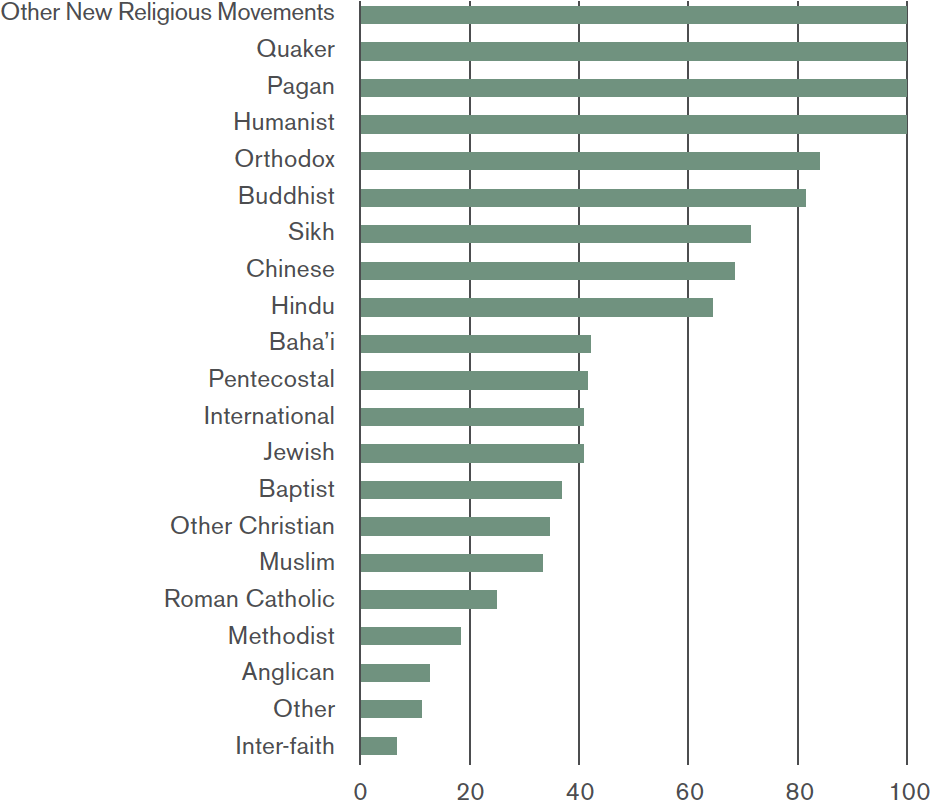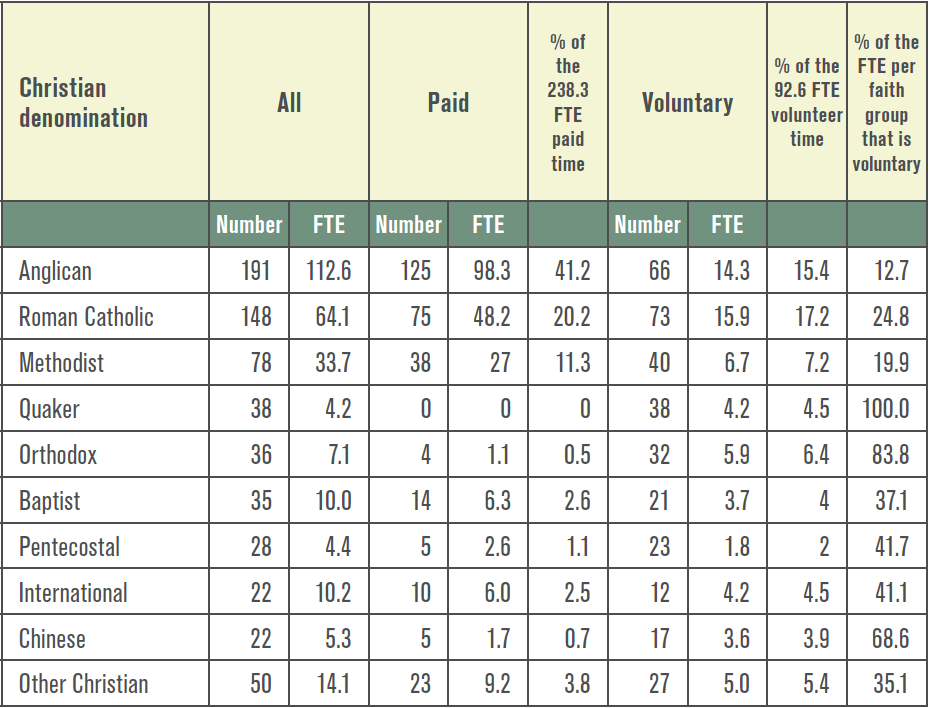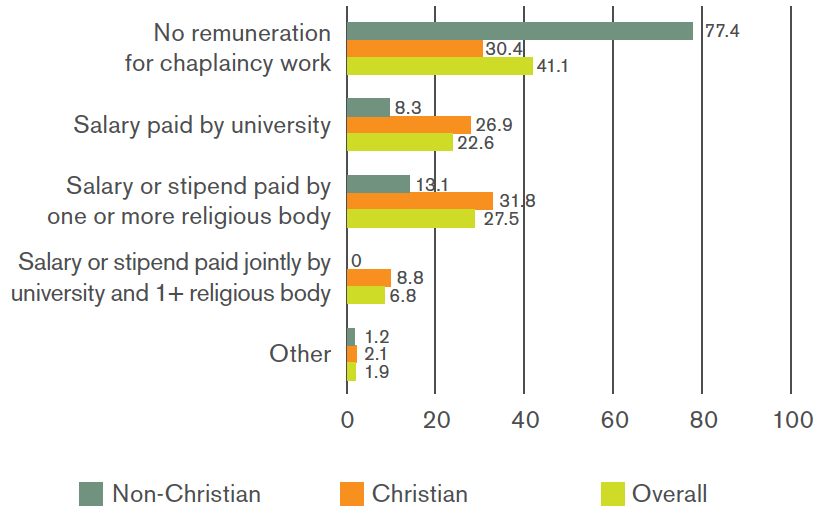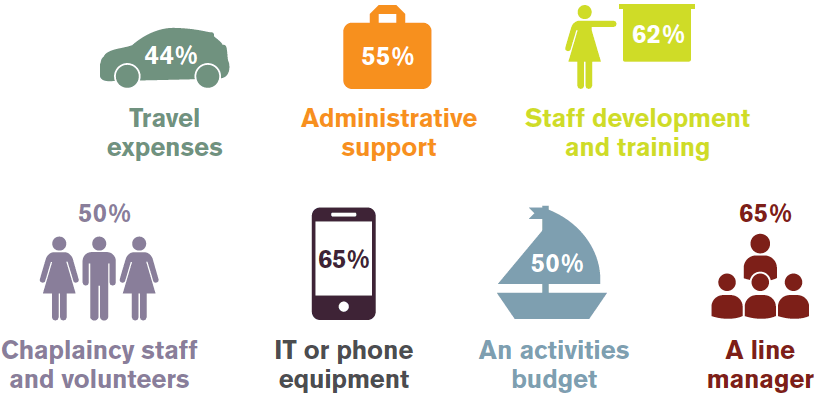The majority of chaplaincy roles are voluntary. When lead chaplains were asked to state the approximate time commitment of every one of their chaplaincy staff and whether they were paid, of 1032 chaplaincy appointments, 63% of chaplaincy roles were cited as voluntary (654 people), 37% (378) as paid. The average university has 10.4 chaplains.
[This might seem generous provision, but as many of these roles are not full time or paid, chaplaincy provision is less than this. Calculating a full-time equivalent figure reveals the true amount of chaplaincy provision in each university. The mean FTE was 3.3, of which 2.4 was paid and 0.9 of time was given voluntarily. FTEs were calculated as follows: working over 30 hours was classed as full-time (1.0), working 5-30 hours was classed as half-time (0.5), working regularly but below 5 hours was classed as 0.07 (estimating an average of 2.6 hours in a 37.5 hour week) and working ‘occasionally’ as 0.02 (estimating an average of three-quarters of an hour per week). These were then added up to produce a total FTE figure for each university and for each religion or belief group. These are estimations of time, so will not be entirely accurate (for example, some people who work occasionally do an hour every fortnight, while others attend only one or two events per year).]
The average (mean) UK university has 10.4 chaplains:

The time they offer equates to 3.3 full-time equivalent (FTE) roles.
2.4 FTE of chaplain time is paid and 0.9 is given voluntarily.
Each year, university chaplains contribute around £4.5 million of volunteer labour to the higher education sector.
[The figure is given for 144 universities rather than the larger 167. The 23 excluded from the calculation includes many new, small and private providers that we did not include in the list of universities we sampled from – the vast majority of these appear to have no chaplaincy. The £4.5 million is derived from the assumption that a modest chaplain salary of £25k, including overheads and pension, would cost a university £35k. At 0.9 FTE given voluntarily, 90% of this amount (£31,500) was then multiplied by 144 universities.]
Volunteer university chaplains give around 3,500 hours of free labour each week.
[Hours calculated by multiplying the 92.6 FTE volunteer chaplains give, by the typical working week (37.5 hours).]
Volunteer chaplains give a huge amount of time to universities. Universities are receiving a substantial amount of chaplaincy work for free, from volunteers and religious organisations. Figure 4 indicates the proportion of chaplaincy time given by chaplains in 99 universities that is given voluntarily, by faith group.

Table 2 outlines the numbers of chaplains working in the 99 universities for which we have accurate figures, differentiated by religion/belief group and by whether they are paid or volunteers. For each religious group, their number of chaplains is listed alongside the number of chaplain roles as a full-time equivalent. For example, if a university had two Muslim chaplains, both working as paid chaplains for half of the week, this would be listed as two Muslim chaplains and 1.0 FTE. In total, there are 1032 chaplains working in the 99 universities, and this equates to 330.9 full-time equivalent posts. Of the 1032, 378 are paid, which equates (because some of them are part time), to a paid FTE of 238.3. The remaining 654 of the 1032 are volunteers, and this volunteer labour equates to 92.6 FTE.

Christians occupy the majority of paid roles, making up 84% of paid chaplain time. The variation among Christian denominations is illustrated by Table 3. Volunteer time extends a little more broadly across faith groups, with Christians giving 71% of volunteer time. The smaller and/or least established the religious group, the more likely it is that its chaplains work without payment. In the larger and longer-established religious groups, chaplains’ time is mostly paid for. The growth of paid Muslim chaplains has been significant over the last decade, and now most chaplaincy time given by Muslims is funded rather than voluntary. Beyond the Abrahamic faiths, chaplains receive virtually no remuneration.

Who pays chaplains?
Churches have historically paid chaplains in many universities. A few universities have historical trusts providing funding. At others, the Church of England, Roman Catholic, Methodist or other free churches in the past agreed to fund or part fund a chaplaincy role, and have continued to do so. But the churches’ financial resources are shrinking, meaning that funding chaplains at the current level may not be sustainable. The Church of England is the largest funder of chaplaincy, providing 98.3 paid FTE across the 99 universities we collected information from; next was the Roman Catholic Church with 48.2 FTE, followed by the Methodist church, with 27 FTE.
The stark difference in the situation of Christian chaplains compared to non- Christian chaplains is revealed in the responses of the 367 chaplains to the question of who pays them, as Figure 5 shows.

77% of non-Christian chaplains were volunteers, compared to 30% of Christians. But this differs by religion. After Christians, the religious group with the largest proportion of chaplains being paid are Jews (55% are paid), followed by Muslims (29%).
Religious bodies are the largest funders of chaplaincy, with 28% of chaplains receiving a salary or stipend from one or more religious body. Only 23% chaplains are paid solely by the university. A further 7% are paid jointly by the university and a religious body. In a very few cases (2%) there is another arrangement (e.g. a local trust). Muslim chaplains we spoke to were more likely than any other group – including Christians – to be paid by their university. [The raised profile of the Preventing Violent Extremism agenda in recent years seems to have been one factor in why universities have started employing Muslim chaplains.] Jewish chaplains are paid by Jewish organisations, most by the body University Jewish Chaplaincy, not by universities.
Do universities provide other resources for chaplains?
Asked if their university provides them with resources contractually made available to paid employees, including opportunities for staff development, travel expenses or IT support, many said no, as Table 4 shows. [10% said ‘no’ to all seven measures. 68% said ‘yes’ to at least three out of seven measures. 19% (70 out of 367 chaplains) said ‘yes’ to all seven measures. Of this 70, over 90% are paid. Only 9% of the chaplains receiving all provisions are volunteers.]
Does your university provide you with…

It seems that many universities do not provide these for their chaplains, especially volunteer chaplains. Including training provided by religion and belief organisations and universities, almost three-quarters (74%) of chaplains said they attended training and development to support their chaplaincy role at least annually. Whether or not they were paid was a strong predictor of attending training – paid chaplains were more likely to attend training than volunteer chaplains. 55% of unpaid chaplains attended training annually compared to 87% of paid chaplains. Not only are volunteer chaplains giving their time for free, but they are also not given resources they are likely to need to do their jobs well.
Consistently less than 50% of volunteer chaplains are given access by their university to IT or phone equipment (40%), travel expenses (28%), administrative support (45%), staff development and training (44%), chaplaincy staff and volunteers (45%), an activities budget (26%). 54% are given a line manager.
In conclusion, although the majority of chaplaincy time is paid, the majority of it by religious organisations, the majority of chaplains are not paid. Universities have many (654 in the 99 universities we have data for) volunteer chaplains on their grounds who are neither paid nor well-resourced, giving around 3500 hours free labour each week to support religious students, but with a marginal, perhaps precarious, status in the university.
The part-time work they do with students of their own faith is valuable and valued, but without a formalised role, they are unable to perform as well as they should be able to, and they are not fully accountable to the university for their work nor able to understand their role within the university’s mission. As the recommendations suggest, universities should increase the resources (financial and other) for chaplaincy, especially in the light of government policies on religion and belief equality, student safety and safeguarding.
